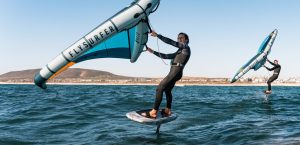eFoils represent a revolutionary approach to water sports, blending the thrill of surfing with cutting-edge technology. Understanding how an eFoil operates and its essential components is key to appreciating this innovative sport.
Understanding the eFoil
An eFoil is a surfboard with an electric propeller mounted beneath it, allowing the rider to glide above the water surface. This unique design combines elements of surfing, flying, and skateboarding.
The Key Components of an eFoil
- Board: The board is the primary component where the rider stands. It's typically made of lightweight yet durable materials like carbon fiber or high-grade plastics. Its size and shape affect the eFoil's stability and maneuverability.
- Motor and Propeller: Located under the board, the motor powers the propeller, providing the necessary thrust to lift the board above the water. The motor's power, often measured in watts, significantly influences the eFoil's speed and efficiency.
- Battery: The battery is the power source for the motor. High-capacity lithium-ion batteries are common, offering a balance of weight, capacity, and longevity. Battery life affects the duration of a ride, while charging time influences overall convenience.
- Foil: The hydrofoil, or foil, is a wing-like structure attached beneath the board. When the eFoil reaches a certain speed, the foil lifts the board above the water, reducing drag and allowing for smoother, faster rides.
- Remote Control: Riders use a handheld remote to control the motor's speed. This remote is usually wireless and waterproof, featuring simple controls for ease of use.
Performance and Specifications
- Speed: eFoils can reach speeds of up to 25-30 mph, depending on the motor's power and the rider's skill.
- Battery Life: Most eFoils offer a battery life of 1-2 hours, influenced by riding style and conditions.
- Charging Time: Battery recharge times vary, typically ranging from 2 to 4 hours.
- Cost and Budget Considerations: The price of an eFoil can be significant, often ranging from $6,000 to $12,000, depending on the brand, materials, and technology.
- Weight and Size: eFoils vary in size, with larger boards offering more stability for beginners. The overall weight, including the battery, is a crucial factor for transport and handling.
Advantages and Materials
eFoils offer several advantages over traditional water sports:
- Accessibility: They do not require waves and can be used on lakes, rivers, and calm seas.
- Eco-friendliness: Electric propulsion means no emissions and minimal environmental impact.
- Excitement and Challenge: The sensation of flying above water is unique, offering a new challenge for water sports enthusiasts.
The materials used in eFoils are typically high-grade composites, ensuring strength, durability, and light weight. Carbon fiber and specialized plastics are common, providing the necessary rigidity and buoyancy.

Lifespan and Maintenance
The lifespan of an eFoil depends on its usage and maintenance. Proper care, such as rinsing with fresh water after use and regular battery checks, can significantly extend its life. Typically, a well-maintained eFoil can last several years.
Potential Drawbacks
While eFoils offer a unique experience, they also have some drawbacks:
- Cost: The initial investment is high, making it less accessible for some.
- Learning Curve: Mastering an eFoil requires practice and balance, which might be challenging for beginners.
- Maintenance: Regular maintenance is essential to ensure longevity and safety.
For more detailed information about eFoils, visit What is eFoil.
